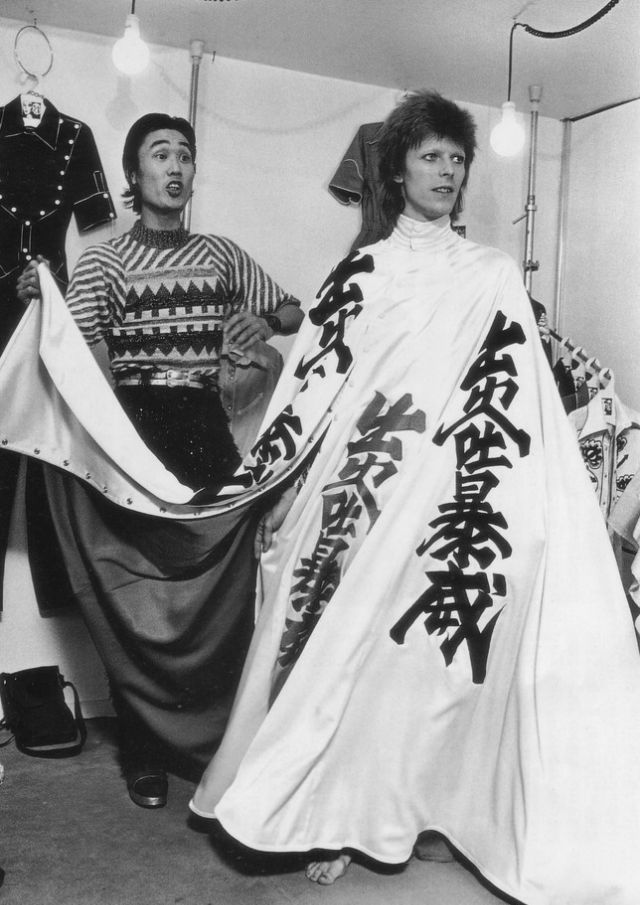One day in 1973, the Japanese designer Kansai Yamamoto received a phone call from a stylist, who insisted that Yamamoto leave Tokyo immediately to catch a plane for New York. The reason? There was someone on the other side of the world that he had to meet.
Thirteen hours by plane and some time after landing in New York, he arrived at Radio City Music Hall, where David Bowie descended from the ceiling during a show, dressed in Yamamoto’s designs. Almost instantly, Yamamoto felt a connection with Bowie. “I felt like I’d known him forever,” he remembered.
Bowie had admired Yamamoto’s work since he made waves as the first Japanese designer to present at London Fashion Week in 1971. His work — heavily influenced by the Japanese concept of Basara, meaning “extravagance, eccentricity, and excess” — fit the essence of Bowie’s developing stage personality. So the singer asked him to design more of his costumes.
Like Bowie, Yamamoto was uninhibited by the confines of gender in fashion — he designed for no one in particular, although his clothing was, and still is, generally worn by women. Several years of collaboration and countless fittings produced what are remembered today as some of Bowie’s most iconic stage costumes, including the asymmetric knit leotard, the wide-leg vinyl Tokyo Pop jumpsuit, and a white cape, emblazoned with Japanese kanji letters, which Bowie stripped off onstage in 1973 during his “Ziggy Stardust” tour.
While his designs undeniably helped Bowie cement his reputation as a forethinker in terms of androgyny and defying gender norms, Yamamoto told The Hollywood Reporter that at first people weren’t so receptive to Bowie’s refusal to acknowledge the gender binary in fashion. “When David wore my women's clothes, people were very surprised. My clothes were designed to be worn by women. When I think of it, it was a bizarre thing for him to do.”
Further speaking of their close, continued collaboration, Yamamoto said their relationship was one built on mutual admiration. After being introduced through a mutual stylist friend, Bowie already owned items by the designer purchased from a shop on the Kings Road, and that without him, “my jumpsuits would still be sleeping at the corner of my little room in Tokyo I had at the time.”
Of their subsequent work together, Yamamoto said, “some sort of chemical reaction took place: My clothes became part of David, his songs and his music. They became part of the message he delivered to the world.”
(via the Cut and Dazed)
Thirteen hours by plane and some time after landing in New York, he arrived at Radio City Music Hall, where David Bowie descended from the ceiling during a show, dressed in Yamamoto’s designs. Almost instantly, Yamamoto felt a connection with Bowie. “I felt like I’d known him forever,” he remembered.
Bowie had admired Yamamoto’s work since he made waves as the first Japanese designer to present at London Fashion Week in 1971. His work — heavily influenced by the Japanese concept of Basara, meaning “extravagance, eccentricity, and excess” — fit the essence of Bowie’s developing stage personality. So the singer asked him to design more of his costumes.
Like Bowie, Yamamoto was uninhibited by the confines of gender in fashion — he designed for no one in particular, although his clothing was, and still is, generally worn by women. Several years of collaboration and countless fittings produced what are remembered today as some of Bowie’s most iconic stage costumes, including the asymmetric knit leotard, the wide-leg vinyl Tokyo Pop jumpsuit, and a white cape, emblazoned with Japanese kanji letters, which Bowie stripped off onstage in 1973 during his “Ziggy Stardust” tour.
While his designs undeniably helped Bowie cement his reputation as a forethinker in terms of androgyny and defying gender norms, Yamamoto told The Hollywood Reporter that at first people weren’t so receptive to Bowie’s refusal to acknowledge the gender binary in fashion. “When David wore my women's clothes, people were very surprised. My clothes were designed to be worn by women. When I think of it, it was a bizarre thing for him to do.”
Further speaking of their close, continued collaboration, Yamamoto said their relationship was one built on mutual admiration. After being introduced through a mutual stylist friend, Bowie already owned items by the designer purchased from a shop on the Kings Road, and that without him, “my jumpsuits would still be sleeping at the corner of my little room in Tokyo I had at the time.”
Of their subsequent work together, Yamamoto said, “some sort of chemical reaction took place: My clothes became part of David, his songs and his music. They became part of the message he delivered to the world.”
(via the Cut and Dazed)





















0 comments:
Post a Comment